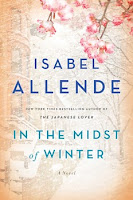She Walks in Beauty by Siri Mitchell

Clara hated that corset. Her corset adventures are beyond funny. I laughed because the corset troubles were not happening to me but to poor Clara. For me, the corset became a symbol of the tight, strict society that these men, women and servants lived through during this time in American History. As I got further in the novel, I wondered what did Siri Mitchell want me to know about my society versus this sociey. I am certainly not white nor rich. Her message came in a song. I have always loved the particular hymn. I will not mention the name of the hymn here. She Walks in beauty made me look at the words of the song in a new light. The song now means more to me than it ever did in the past. I also have a deeper respect for the hymnal used by my family and I at different times in my life. Clara's mother loved to read hymnals because the words of the hymns were so rich with meaning. For example, Clara mentions her mother's love of the words in the song What a Friend I Have in Jesus.
Completely cocooned in this wonderful novel I began to admire and yearn to read Byron's poems. That was an odd feeling. I've read two or three of his poems in literature books. I wasn't knocked off my feet. People who love Byron will know the title and the words of the poem by heart.
I loved every bit of this novel especially the mention Jacob Riis. Siri Mitchell mentions the Astors and the Vanderbilts. My knowledge is slim and none about these famous and rich historical people. I did recognize the name Jacob Riis. He was a great reformer. He worked hard to change the living conditions of the poor in New York. He wanted children to be given the best health care. He hated the filthy tenements. "At that time 43 percent of the city's buildings were defined as tenements and fully two-thirds of the city's population lived in the squalor and destitution that Riis described in his book." This part of the book is special to me because a family member had read about Jacob Riis and talked daily about Jacob Riis and his work to me. So I can not forget this man's name not even if I wanted to forget it.
I also loved all the tidbits of American History in the book. I now want to read a book about Tammany Hall and its political agenda. I did not know this era was the Victorian Age of America. I thought only England had a Victorian Age. "The late-Victorian period in America produced our society's first celebrity culture." I can gladly say this novel, She Walks in Beauty, took me to a world of beauty, romance, unfairness and gave me deeper insight in to God's Love for me. I feel as contented as Clara who toward the end of her struggle relaxed by slipping on a "dressing sacque." Clara says "I found my Byron, took up the apple, and burrowed into my bed." By the way there are two very important Prince Charmings in the novel. I would feel guilty if I did not mention the DeVries brothers. Anyway, I'm back to my apple. I'm thinking about the glories of a spiritual love and that passionate, earthy type of love Clara desires so much. Siri Mitchell



Comments